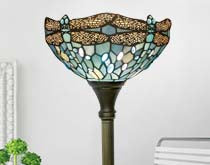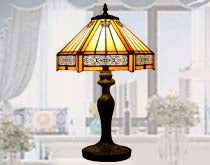Tiffany Chandeliers vs. Tiffany Ceiling Lights
Werfactory Tiffany lamps offers you different styles of Tiffany ceiling lamps and Tiffany pendant lamps.
If you're torn between choosing a Tiffany chandelier or a Tiffany ceiling light, this blog might be of help.
The subsequent discussion delves deeply into the pros and cons of chandeliers and ceiling lights, shedding light on their potential influence on illumination.
Through the lens of this article, we aspire to guide your decision-making process, helping you discern whether a ceiling light or a chandelier aligns more with your aesthetic and functional needs.

Related reading: Dale Tiffany Flush Mount Ceiling Light vs Werfactory Tiffany Flush Mount Ceiling Light
What is a Tiffany Ceiling Light?
The Tiffany Ceiling Lamp is an exquisite lighting fixture designed to sit close to the ceiling, forming a harmonious parallel with it, almost becoming one with it. This design allows for a very short distance between it and the ceiling, bringing a cleaner and more fluid visual effect to the interior space.
And when we talk about semi-flush-mounted ceiling lamps, this design, although the distance between it and the ceiling is slightly longer, making it slightly protrude from the ceiling, still occupies far less space than a traditional chandelier. This design not only saves interior space but also brings a modern, minimalist yet elegant atmosphere to the home environment.

Uniform Lighting
Ceiling lights are a popular choice in home lighting, particularly for their ability to provide uniform and widespread light distribution. Unlike other types of fixtures, ceiling lights are designed to disperse light broadly, ensuring the entire room is well-lit. This uniform light distribution helps reduce or eliminate shadows, making the space visually harmonious.
Moreover, uniform lighting isn't just about practicality. Soft and even lighting can create a cozy, comfortable ambiance in a room, making family members and guests feel relaxed and welcomed. Whether you're preparing food in the kitchen, reading a book in the living room, or unwinding in the bedroom, uniform lighting adds a touch of comfort to our daily lives.
Thus, opting for ceiling lights is not just for their practical illumination but also for crafting a delightful and harmonious living space.
Space-saving
In modern home design, efficient use of space has become increasingly crucial, especially in urban apartments or compact residences. Here, ceiling lights prove to be invaluable. Since they are mounted flush against the ceiling, unlike chandeliers or hanging fans that dangle, ceiling lights don't occupy much vertical space. This design not only conserves precious space but also imparts a sense of neatness and order to the room.
More importantly, as they don't intrude into the central space, ceiling lights offer greater flexibility for furniture arrangement and room layout. Whether it's a small living area or a narrow corridor, ceiling lights ensure your space remains unobstructed while still providing ample illumination.
Disadvantages
- Less Eye-catching: While they embody Tiffany's aesthetic features, they might not be as stunning as chandeliers.
- Design Limitations: Due to their structural constraints, there might be limitations in artistic creativity and design.
What is a Tiffany Chandelier?
A Tiffany chandelier is a harmonious blend of art and illumination. Originating from the artistic vision of Louis Comfort Tiffany in the late 19th century, these chandeliers typically consist of an array of exquisite colored glass pieces, depicting a variety of natural or abstract patterns.
As a home lighting option, chandeliers stand out from the crowd because of their versatility and design ingenuity. One of its representatives is the chandelier, which mimics the shape of a tree branch, with one or more bulbs hanging from each branch as if they were the fruit of the tree. This design not only ensures a wide distribution of light but also brings a natural, vibrant feeling to the interior space.
The pendant chandelier, on the other hand, represents the minimalist side of the chandelier family. It usually consists of one or several bulbs suspended from a slender chain or metal rod and has a simple yet elegant design
Although it does not have the complex structure of the chandelier, its unique sense of art and exquisite appearance can also add a chic charm to the home environment. Whether in a modern living room or a vintage-style study, pendant chandeliers can be the highlight of the space, bringing a unique artistic atmosphere to your home.
Masters of Ambiance
The colored glass design of Tiffany chandeliers emits a soft and colorful glow, creating a warm, romantic atmosphere in the room. Whether on a chilly winter night or a sweltering summer day, a Tiffany chandelier brings a touch of warmth and comfort.
Center of Attention
Be it in the living room, dining area, or bedroom, a Tiffany chandelier invariably becomes the focal point. Its distinctive design and vibrant glass captivate the gaze of anyone entering the room, making it a topic of discussion and admiration.
Disadvantages
- Expensive: Owing to their unique design and high-quality materials, they tend to be pricier.
- Maintenance: These fixtures often demand more upkeep and cleaning to maintain their beauty and luster.
- Space Requirements: Due to their larger size and distinctive design, they typically require more space and higher ceilings to truly showcase their beauty.
Tiffany Lighting Style and Its Impact on Light
Tiffany lights, be it chandeliers or ceiling lights, are renowned for their signature colored glass designs. While visually stunning, these designs can influence the color and intensity of the light.
Dense-colored patterns, compared to transparent glass fixtures, might diffuse the light, casting a gentler glow. This can create a warm, intimate ambiance but might not be ideal for tasks requiring bright, focused lighting.
Furthermore, the design and positioning of the fixture can also play a role. Chandeliers, with bulbs facing downwards, can concentrate light more directly below, making them ideal choices over dining tables or central room positions.
In contrast, ceiling lights, especially those designed upwards, can offer a more even light distribution, suitable for general room illumination.
Related reading: Tiffany Creative Lighting: different forms of lighting
Conclusion
Tiffany lighting, with its rich history and unparalleled designs, offers homeowners the opportunity to infuse art and elegance into their spaces.
Whether you choose a show-stopping chandelier or a subtly beautiful ceiling light, understanding their benefits, limitations, and impact on lighting can guide you in making an informed decision. After all, in the dance of light and design, the key is to find the perfect partner.























